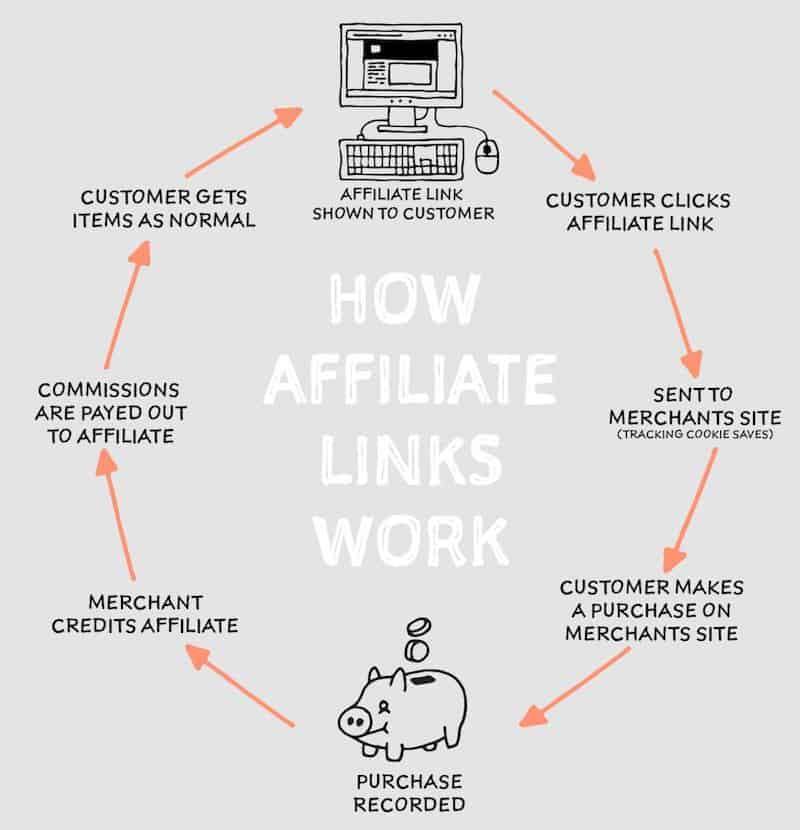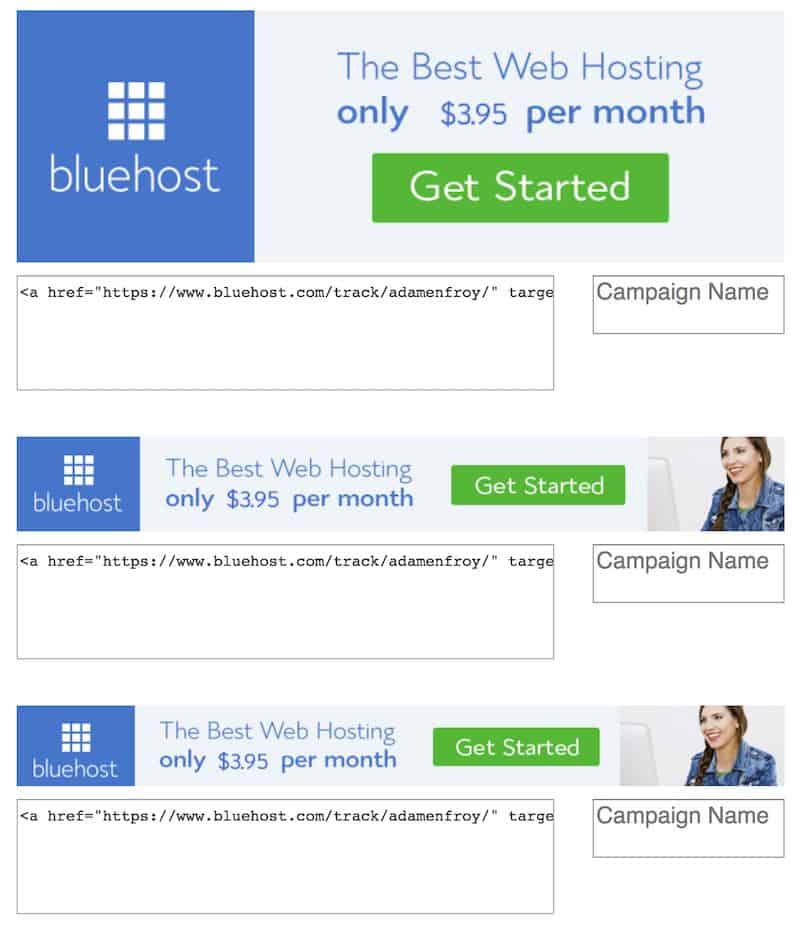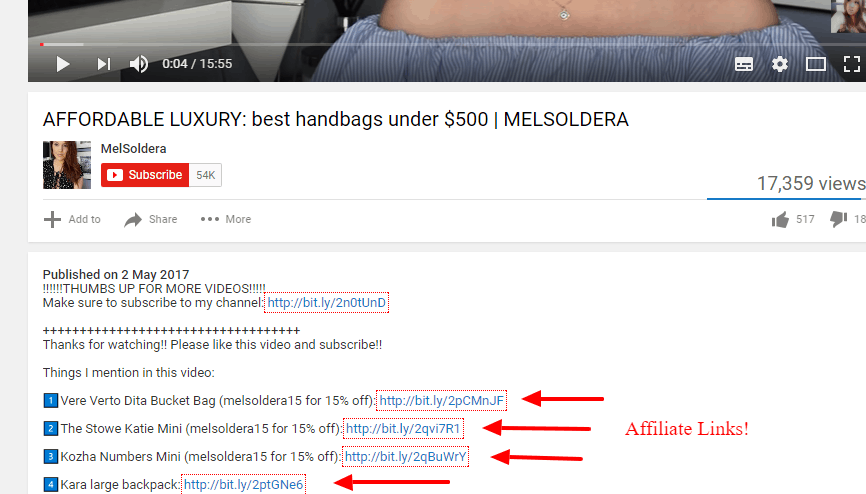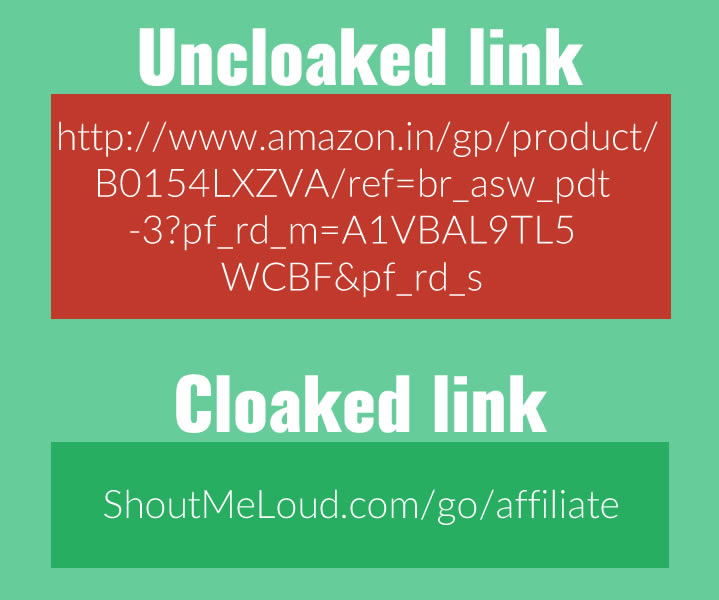How To Link Your Verses In Your Blog
Affiliate marketing is one of the best ways bloggers can turn their content into a passive income stream. And by joining a high paying affiliate program and maximizing the effectiveness of your affiliate links, you will generate more revenue from every click.
Affiliate marketing programs account for 15 percent of all revenue generated from digital media online and is projected to grow 10 percent annually until 2021.
So, how do you enter the world of affiliate marketing, start a successful blog, and use affiliate links to generate a steady income?
In this guide, you'll learn how to acquire affiliate links, use the best tactics for promoting your links and driving website traffic, and become a successful affiliate marketing blogger.
Let's get started.
What Are Affiliate Links?
Affiliate links are exclusive URLs used to track the traffic sent from your website to the advertiser's website. Each affiliate marketer has their own individualized URLs, which contain specific identifiers such as a randomized series of numbers and letters, your username, or other means of identification.

Source: scotthurtado.com
When a website visitor clicks your affiliate links, a record is sent to the affiliate program to track your metrics such as clicks, sales, and commissions. You will typically only earn a commission if the visitor makes a purchase, but you may get paid for leads as well.
In addition to your individualized ID in the URL, affiliate programs also use cookies to track activity. When a reader clicks on your affiliate links, a small file known as a cookie is placed onto their computer. This cookie then records the user's actions and credits your affiliate account with the sale if a product is purchased within a cookie duration window (typically 30-90 days).
How to Get Affiliate Links.
Prior to learning how to promote affiliate links, you must first join an affiliate program.
1. Join an Affiliate Network and Affiliate Programs.
There are numerous affiliate programs available to publishers and website owners. Do your research and see which programs are aligned with your marketing goals, content topics, and interests. A few of the top programs include:
- ShareASale
- CJ Affiliate
- Impact Radius
When researching the best affiliate programs, look into the merchants available, commission rates, as well as rules for applying. Certain affiliate programs require applicants to meet particular restrictions to qualify as an affiliate marketer. If you're just starting out, I recommend you join Shareasale.
2. Log in to Your Affiliate Dashboard and Locate the Links.
After you've been approved, log in to your affiliate program to find your affiliate links.
Using this dashboard, you can select which of the advertiser's text links or banners you'd like to promote on your website. Once you've selected the text link, your exclusive affiliate links will be automatically generated for you to promote with embedded HTML or just the link itself.
3. Copy and Paste the HTML or Direct Link Into Your Content.
After you've found the respective advertiser and selected a type of affiliate link, you'll need to copy the HTML code or direct link. Then, paste this code and/or link into your blog content or website.
You can also use a WordPress plugin like ThirstyAffiliates to cloak your affiliate links and make them look nicer on your site. For example, something like www.adamenfroy.com/go/wpengine looks better than a random string of numbers and letters.
Another great tool for link tracking is ClickMeter. They help you monitor, track, and optimize all of your affiliate links in one place. They also have a popular affiliate program that provides a 90% commission rate when you promote their link tracking tool.
4. Track the Success of Your Affiliate Links in the Dashboard.
Now that your affiliate links are live, return to your dashboard to track their success. Each platform is slightly different, but you'll be able to see the number of clicks, sales, and commissions using this tool.
Now let's move onto the best ways to use your affiliate links to make money online this year.
11 Easy Ways to Promote Affiliate Links.
After Google AdSense and its alternatives, a report found publishers said affiliate links generated more revenue for their website than other forms of marketing. This is due to the ability to promote affiliate links through various tactics, platforms, campaigns, and forms of content.
To be a successful affiliate blogger, start by promoting your affiliate links in these top 11 places.
1. Affiliate Website Reviews.
Just as you were researching affiliate marketing programs to join, you should deeply understand the companies that you're promoting and the tools or products they offer.
Use this opportunity (and include your affiliate links) to write honest reviews about the products you're promoting. Your first focus should be on keyword research and including headings that best match a searcher's intent when researching the product you're promoting.
In these reviews, provide in-depth information about everything a potential customer would need to know, such as:
- How to get set up or buy the product.
- The top pros and cons of using the product.
- Examples of others who have been successful with the product.
- Tips to be successful with the product that your audience can use.
While you are using these reviews to generate clicks on your affiliate links, it is important to be objective, fair, and transparent with your content. Other review sites are also one of the top places to promote your own website, so make sure to know how they work inside and out.
2. Deep Product Tutorials.
On top of developing reviews of the products themselves, you can also promote affiliate links by creating in-depth product tutorials. This is similar to reviews, but you're taking a deep dive into "how-to" focused content. For instance, if you join the Amazon Associates affiliate program, select products you have experience with and write content around:
- How to use the product.
- How to order the product.
- The pros and cons of the product.
- Where to find the product.
- Insider product tips.
3. Affiliate Banners.
In addition to text links in your blog content, affiliate programs also provide links in the form of affiliate banners. You can place these clickable banners in several places on your website, such as:
- The sidebar of your blog.
- The header and footer of your website.
- Embedded in blog content.
- In email marketing messages.
To use affiliate banners, first, check to see if your respective affiliate program offers this capability. Then, copy and paste the provided HTML into the desired spot on your website.
For example, here are some banners you can copy and paste into your site with the Bluehost affiliate program:

If you have difficulty doing so, don't be afraid to reach out to the affiliate program's manager for help. Keep in mind that "banner blindness" is making banners less effective, so employ contextual text links as often as possible.
4. Automated Welcome Emails.
As an affiliate marketer and blogger, building up a loyal following of readers is crucial to long term success. Email marketing is an advantageous tactic for driving visitors to your website, distributing your content, and managing relationships with readers.
Once readers subscribe to your blog, send them an automated welcome email series. In this email, utilize affiliate links by sharing relevant articles. However, don't be spammy with your links.
For example, if your 7-part welcome email series is about starting a WordPress site, don't automatically litter email 1 with a bunch of affiliate links. First, build trust with your readers by telling your unique story, then eventually provide information that will help them most. Affiliate revenue is secondary to helping your readers.
5. Resources or Tools Pages.
To produce ongoing and passive revenue from your affiliate links, you need to position yourself as an authority or thought leader on particular topics.
As part of your marketing strategy, create a Resources page on your website highlighting the top tools and products you recommend. On this page, list and discuss the products you regularly use and recommend – and you can't fake this. You must authentically use the products on your resource page and love them so that you know your readers will benefit from their use.
6. Inside of Digital Products.
As you grow your website and following, you can also begin to create and provide exclusive digital products such as eBooks and online courses to your audience. Naturally, these digital products provide perfect opportunities to embed your affiliate links inside.
Be sure to include these links organically into your content. Your digital products shouldn't feel like sales material, but rather moments for readers to learn more about a particular topic.
For example, if you have an online course about starting a blog, section 1 may include an affiliate link to sign up for Bluehost as a hosting provider. It's a natural place to put your affiliate link inside of your course.
7. YouTube Affiliate Links.
You know videos are a powerful marketing tool, especially for affiliate marketers. In fact, Animoto found 93 percent of businesses reported gaining a new customer as a direct result of a video posted on social media.
As an affiliate marketer, you have the ability to create video content around a variety of topics and include your affiliate links in the process. There are two main ways to embed affiliate links into your video content.

Source: vloggingguides.com
First, the easiest way to use YouTube affiliate links is by including them in your video description. If you use this tactic, be sure to verbally and visually call out the description in your video. Most YouTubers use phrases such as "Click on the links in the description below" to direct viewers to the right place.
The second tactic is to use YouTube annotations. These are the transparent boxes that pop up at preselected times and places within a YouTube video, often with a call-to-action. Each box is hyperlinked, offering the perfect placement for your affiliate links.
For the best results, use both YouTube affiliate link tactics to your advantage.
8. Promoting Affiliate Links on Facebook.
Another place to distribute your affiliate links is on Facebook via your personal profile or a Business page.
Make sure you're not spamming your followers' Facebook feeds with affiliate link posts. Your goal is to convince someone to click on your affiliate links and make a purchase. Do so by posting entertaining, educational, and intriguing content that includes affiliate links.
9. Instagram Affiliate Links.
Much like promoting affiliate links on Facebook, you can also generate affiliate traffic from your Instagram posts. However, Instagram has one major exception: Instagram posts are not clickable.
Instead, you must drive fans to your bio to click on a link.
A workaround to this problem is to include links in Instagram Stories. Once you gain more than 10k followers, you can add links to your Instagram Stories content.
If selling on Instagram is a priority, make it a point to first build a loyal audience. These loyal followers will be more likely to click on your affiliate links, whether in the bio or Instagram Stories and engage with your content.
10. Pinterest Affiliate Links.
Since Pinterest is a visual social media platform, you have several opportunities to drive traffic to your affiliate links, especially those which promote physical products.
For the best results, create pins and boards around a particular product. Or, you can include a pin with your affiliate link in a board focused on a broader topic.
For example, if you are an affiliate marketer for a nutrition company, create a Pinterest board around healthy eating tips, ideas, and recipes. Within that board, make sure to include one or two pins that use your affiliate links.
Test out both tactics and see which one drives the best results by checking your affiliate dashboard as well as Pinterest Analytics.
11. Twitter Affiliate Links.
Using affiliate links on Twitter involves a bit of wordplay. Since you only have 280 characters to convince someone to click on your affiliate link, you need to be creative. Experiment with different styles of copywriting and see which method drives the most affiliate link clicks.
You can also pair your social media copy and links with an image or video to create more intriguing content for your target audience.
However, most affiliate marketers use Twitter to generate traffic to their website and blog content. From there, they use other tactics we've reviewed to entice users to click on the embedded affiliate links.
How to Disclose Your Affiliate Links
As an affiliate marketer, you are required to disclose your involvement in affiliate programs. Most content creators will include a short paragraph explaining the relationship between the content and the affiliate program advertiser at the beginning of their content and on a dedicated page of their website.
An example of a proper affiliate link disclosure at the top of a blog post could read:
"As a blogger, my content may include affiliate links from advertisers. I may earn money from actions readers take on these links, such as a click, purchase, or subscribe. However, these are the tools that I recommend fully and have helped my blog tremendously."
On your dedicated affiliate disclosure page, be sure to list which affiliate programs you are involved with and details about that partnership for the ultimate transparency.
Check out these examples for inspiration.
If you do not include an affiliate link disclosure, you risk violating FTC policies and potentially facing a fine. In addition, affiliate advertisers have the power to remove you from their programs if you fail to disclose your participation appropriately online.
Five Tips to Be Successful with Your Affiliate Links.
The affiliate marketing landscape is always changing and bloggers need to keep up with the trends to maximize their blog monetization. In 2019, use these five tips for continued affiliate marketing success.
1. Use Affiliate Link Cloaking.
Affiliate links can be lengthy, depending on the identifiers a program uses.
Instead, use an affiliate link cloaking tool such as the ThirstyAffiliates WordPress plugin to automatically shorten your links. Using the plugin's WordPress dashboard, you can manage your links, add them into relevant content, and utilize advanced features such as geo-targeting.

Source: shoutmeloud.com
Not only does an affiliate link cloaking tool make tracking and managing your links a breeze, but it also presents your links in a professional, branded manner.
2. Promote Multiple Affiliate Products.
As an affiliate marketer, there's no limit to the number of products and advertisers you can promote. If you run a travel blog, you can promote everything from airline affiliate programs to luggage companies, travel gear, hotels, and more.
And, if you decide to diversify your content, be sure to group content into categories. For instance, if you run a fashion blog, you can join affiliate programs for makeup, clothing, and accessories. Create multiple forms of content for each category and silo them into specific sections of your site.
This ensures your content is easily found and you have several revenue streams at the same time.
3. But, Don't Overdo It with Too Many Products.
Following our previous example, it wouldn't make sense to create content promoting a web hosting company on a website dedicated to fashion.
While you're free to enroll in as many affiliate programs as you like and qualify for, overdoing it can cause confusion for readers, as well as organizational problems for you.
If you wish to participate in affiliate programs for different industries, try creating individualized websites for each topic rather than writing content for all industries on one website.
4. Diversify Your Affiliate Link Placement.
Today, we've reviewed various places to promote your affiliate links. It's in your best interest to diversify where you use your links to maximize revenue.
Promote your affiliate links in:
- Blog content and reviews.
- Product tutorials.
- YouTube videos.
- Banner ads.
- Social media posts.
- Email marketing messages.
- Digital products (i.e. eBooks, online courses).
Your possibilities are endless. Why limit yourself?
5. Put Your Audience First.
Ultimately, it's all about your audience. Never create content for the sake of promoting a link if your audience won't respond to it. First, gain a deep understanding of your audience's needs, wants, and pain points. Then, publish content that provides the best possible solution.
Your goal is to give your audience the best possible content (that can also generate sales for through affiliate links). But, if your audience doesn't know, like, and trust you, there is no chance of generating a sale.
Executive Summary.
Now that you know all about how affiliate links work, where to promote them, and how to fully disclose your participation in affiliate programs, it's time to put your newfound knowledge to use.
First, check out some high paying affiliate programs to join, grab those links, put them in the best places for your audience, and start monetizing your blog today.
Here's hoping these affiliate link tips start helping you earn more from every click.
How To Link Your Verses In Your Blog
Source: https://www.adamenfroy.com/affiliate-links
Posted by: hancockmanote.blogspot.com

0 Response to "How To Link Your Verses In Your Blog"
Post a Comment